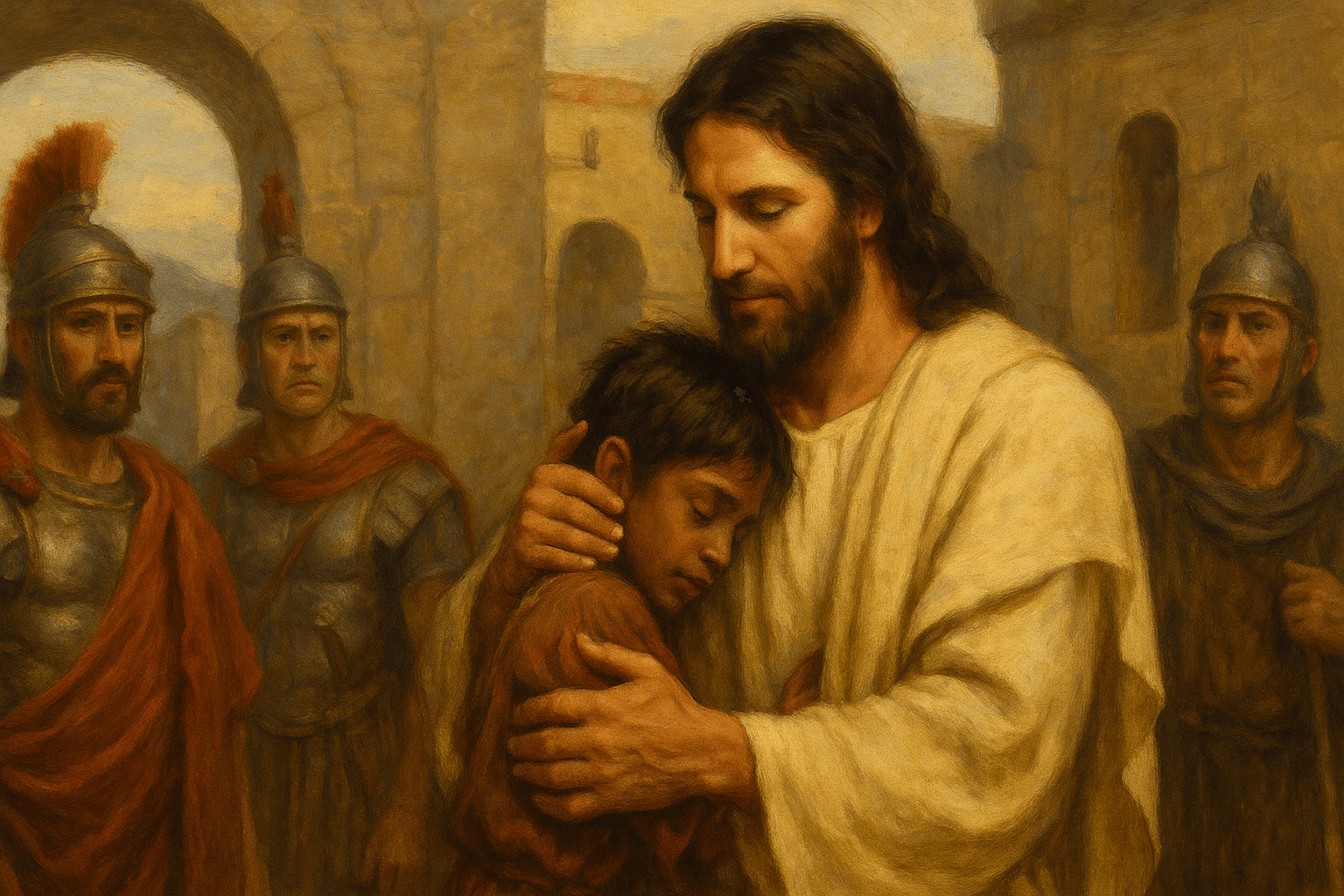In einer Welt, die sich nach Verbindung, Heilung und authentischer Liebe sehnt, spricht die moralische Lektion des barmherzigen Samariters lauter denn je. In Lukas 10:25-37 gefunden, fängt diese von Jesus selbst gesprochene Parabel das Wesen dessen ein, was es wirklich bedeutet, das christliche Leben zu leben. Es geht weit darüber hinaus, einfach jemandem in Not zu helfen. Im Kern lehrt diese Geschichte über Gottes Liebe, Glauben in Aktion und die Art von Mitgefühl, die das Herz Christi widerspiegelt.
Die Schönheit der Geschichte liegt in ihrer Einfachheit und Tiefe. Die moralische Lektion des barmherzigen Samariters fordert jeden Jünger Jesu heraus, über Religion, Rasse und soziale Grenzen hinauszuschauen, um die Gnade Gottes zu verkörpern. Während wir den biblischen Reichtum dieser Passage erforschen, werden wir nicht nur ihre historische und kulturelle Tiefe aufdecken, sondern auch ihre zeitlose Relevanz. Was bedeutet es, ein Nächster zu sein? Wie leiten uns Glaube, Erlösung und der Heilige Geist im täglichen Leben?
Lasst uns gemeinsam durch die Parabel reisen und entdecken, wie sie den Ruf zur Jüngerschaft, die Realität des ewigen Lebens und die verwandelnde Liebe Jesu offenbart.
Der Kontext der Parabel: Wer ist mein Nächster?
„Er aber wollte sich rechtfertigen und sprach zu Jesus: Wer ist denn mein Nächster?“
— Lukas 10:29
Der Schauplatz
Die Parabel beginnt mit einer Frage eines Gesetzeslehrers, der Jesus prüfen wollte. Diese Frage, "Wer ist mein Nächster?", mag einfach erscheinen, aber im Judäa des ersten Jahrhunderts trug sie kulturelles, theologisches und sogar politisches Gewicht. Das jüdische Gesetz hatte Nachbarn bereits primär als jüdische Mitbürger definiert. Die radikale Wendung in Jesu' Antwort schreibt die Grenzen der Liebe neu.
Ein unerwarteter Held
Zu Jesu' Zeiten hegten Samariter und Juden gegenseitige Verachtung. Die Teilung dauerte Jahrhunderte und wurzelte in historischen Verrätereien und doktrinären Differenzen. Dass Jesus einen Samariter zum Helden der Geschichte machte, hätte seine Zuhörer schockiert. Doch gerade durch diesen Kontrast bringt Jesus seine Botschaft ans Licht.
Gottes Liebe kennt keine Grenzen
Dieser Abschnitt offenbart eine tiefe Wahrheit: Die Liebe Gottes kann nicht auf unsere Definitionen beschränkt werden. Im barmherzigen Samariter lehrt Jesus, dass es bei Erlösung und Mitgefühl nicht um Status oder Herkunft geht, sondern um Handeln, das in Gnade wurzelt.
Mitgefühl in Aktion: Was der Samariter tat
„Ein Samariter aber, der auf der Reise war, kam dahin; und als er ihn sah, hatte er Mitleid mit ihm, ging zu ihm hin und verband seine Wunden...“
— Lukas 10:33-34
Eine Liebe, die bewegt
Die Handlungen des Samariters werden detailliert beschrieben: er sieht, hält an, verbindet Wunden und bietet seine eigenen Ressourcen an. Dies war keine schnelle Wohltätigkeitsaktion. Es war persönlich, kostspielig und störte seinen Zeitplan. Das ist das Bild christusähnlicher Liebe.
Der Heilige Geist in uns
Diese Geschichte spiegelt den Charakter von jemandem wider, der mit dem Heiligen Geist erfüllt ist. Mitgefühl ist nicht nur Emotion; es ist eine Frucht des Geistes (Galater 5:22-23) und ein Beweis für ein verwandeltes Herz. Wenn Gottes Liebe in uns wohnt, können wir nicht anders, als uns auszustrecken.
Eine kulturelle Umkehrung
In der rabbinischen Tradition ging es bei Heiligkeit oft um die Trennung von Unreinheit. Doch hier preist Jesus jemanden, der Wunden berührt und sich nähert. Diese Umkehrung nimmt die Kraft des Evangeliums vorweg: Jesus, der Heilige, trat in unsere Gebrochenheit ein, um Erlösung zu bringen.
Glaube ohne Grenzen: Religiöse Barrieren durchbrechen
„So ist auch der Glaube, wenn er keine Werke hat, tot in sich selbst.“
— Jakobus 2:17
Mehr als Religion
Zwei religiöse Figuren gehen an dem verwundeten Mann vorbei – ein Priester und ein Levit. Ihre Handlungen werfen unbequeme Fragen auf. Könnte es sein, dass rituelle Pflicht wichtiger geworden war als Gottes Liebe? Jesus weist uns auf einen Glauben hin, der über die Tradition hinaus zu aktiver Barmherzigkeit führt.
Die Rolle der Jüngerschaft
Jüngerschaft bedeutet, das Leben und die Lehren Jesu zu verkörpern. Er trennte den Glauben nie von der Liebe. Christ zu sein bedeutet, zu dienen, zu heilen und in Barmherzigkeit zu handeln. Jeder Gläubige ist berufen, nicht nur zu glauben, sondern ein Gefäß der Liebe Gottes zu werden.
Mitgefühl als Zeugnis
Wenn Christen diese Parabel ausleben, wird unser Zeugnis greifbar. Die Welt sieht Jesus durch uns. Wie der Samariter werden wir zu einem lebendigen Zeugnis der Gnade.
- Wir verkörpern Glauben in Aktion
- Wir spiegeln Gottes Liebe den Vergessenen wider
- Wir fordern Stereotypen durch Freundlichkeit heraus
Der innere Weg: Gott und den Nächsten lieben
„Du sollst den Herrn, deinen Gott, lieben mit deinem ganzen Herzen... und deinen Nächsten wie dich selbst.“
— Lukas 10:27
Ein Gebot, zwei Richtungen
Jesus bekräftigt, dass die Liebe zu Gott und zum Nächsten untrennbar sind. Wahre Jüngerschaft lebt in beiden Bereichen. Dies ist keine Wahl zwischen Hingabe und Dienst. Vielmehr findet die Liebe zu Gott ihren Ausdruck darin, wie wir andere behandeln.
Gebet und Praxis
Geistliches Wachstum beinhaltet mehr als Gebet und Anbetung. Es erfordert eine Offenheit für die Eingebung des Heiligen Geistes in unserem täglichen Leben. Ob bei der Arbeit, in unseren Familien oder bei Fremden, Möglichkeiten zur Liebe gibt es zuhauf.
Eine tiefere Symbolik
Einige frühe christliche Lehrer sahen die Parabel als eine Allegorie der Erlösung: Der Mann repräsentiert die gefallene Menschheit; die Räuber, die Sünde; der Samariter, Jesus; das Gasthaus, die Kirche. Diese Interpretation erinnert uns daran, dass Gott nicht an uns vorbeigegangen ist – er kam in Christus zu uns.
Die Parabel heute leben
„Wahrlich, ich sage euch: Was ihr getan habt einem von diesen meinen geringsten Brüdern, das habt ihr mir getan.“
— Matthäus 25:40
Moderne Samariter
Der Ruf dieser Parabel geht über ihren antiken Schauplatz hinaus. In unseren Städten und Gemeinden liegen Menschen auf unzählige Weise verwundet da – emotional, spirituell und physisch. Ein Nächster zu sein kann heute bedeuten, ein offenes Ohr zu schenken, eine warme Mahlzeit anzubieten oder einfach jemanden wahrzunehmen, den andere ignorieren.
Geschichten der Gnade
In einer ruhigen Stadt bezahlte ein Mann anonym die Beerdigung eines obdachlosen Fremden, den er nie getroffen hatte. Auf die Frage, warum, zitierte er Lukas 10 und sagte: "Er war mein Nächster." Momente wie diese spiegeln das lebendige Evangelium wider.
Ein Leben von ewiger Bedeutung
Jesus beendet die Parabel mit den Worten: "Geh und handle ebenso." Es ist kein Vorschlag, sondern eine Beauftragung. Die moralische Lektion des barmherzigen Samariters ist ein Fahrplan für ein Leben, das in der Ewigkeit Früchte trägt.
Schlussfolgerung: Geh und handle ebenso
Die moralische Lektion des barmherzigen Samariters handelt nicht nur von Freundlichkeit; sie handelt von Transformation. Sie zeigt uns das Herz Gottes – ein Herz, das sieht, anhält, heilt und wiederherstellt. Sie erinnert uns daran, dass das Christentum nicht nur ein Glaubenssystem ist, sondern ein gelebtes Zeugnis der Gnade Gottes.
Lasst uns als Jünger Jesu täglich fragen: Wer braucht heute meine Hilfe? Wer ist mein Nächster? In jeder Tat des Mitgefühls spiegeln wir die Liebe Christi wider, geleitet vom Heiligen Geist, gestärkt durch das Gebet und berufen, ewiges Leben zu teilen.
Die Parabel spricht immer noch. Sie fordert uns auf, anders zu leben. Opferbereit zu lieben. Und in die Fußstapfen dessen zu treten, der nicht gekommen ist, um bedient zu werden, sondern um zu dienen.
.png)
.png)
.png)
.png)
.png)
.png)
.png)


.png)
.png)


.png)
 (1).png)
.png)

.png)
.png)
.png)
.png)